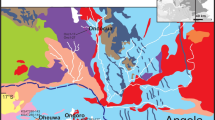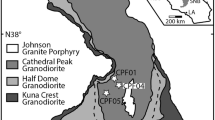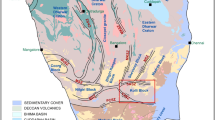Abstract
Samples containing allophane with molar Al/Si ratios from 1.0 to 2.0 have been examined by infrared spectroscopy, X-ray fluorescence, and phosphate adsorption methods. The infrared spectra of allophane with Al/Si ratios close to 2.0 showed that the wall of the allophane spherules is made up of imogolite structural units similar to “proto-imogolite.” X-ray fluorescence gave no clear evidence of Al in tetrahedral sites (AlIV), while pyridine adsorption results suggested that a small number of Bronsted acid sites (AlIVOH) are present in silica-rich allophanes. Lewis acid sites (AlH2O) are present in both silica-rich and alumina-rich allophanes. The results suggest that the framework for the allophane structure is an Al octahedral sheet.
Allophanes with Al/Si ratios close to 1.0 contain condensed silicate units either on the outside surface of the Al octahedral sheet, giving rise to a halloysite-h’ke structure, or bonded on the inside surface of an imogolite-like structure. Allophanes with Al/Si ratios between 1.0 and 2.0 appear to be mixtures of the “proto-imogolite” structure and the allophane (Al/Si = 1.0) structure.
Резюме
Образцы, содержащие аллофан с молярными отношениями Al/Si от 1,0 до 2,0, были исследованы методами инфракрасной спектроскопии, рентгеновской флюоресценции, и фосфатной адсорбции. Инфракрасные спектры аллофана с отношениями Al/Si близкими к 2,0 показали, что оболочка аллофановых сфер состоит из имоголитовых структурных единиц похожих на «прото-имоголит». Рентгеновская флуоресценция не дала ясного доказательства присутствия Аl в тетраэдрических структурах (AlIV), тогда как результаты пиридиновой адсорбции указывают на то, что небольшое количество кислотных структур Бронстеда (AlIVOH) присутствует в аллофанах богатых кремнеземом. Кислотные структуры Льюиса (АlН2O) присутствуют как в аллофанах богатых кремнеземом, так и в аллофанах богатых алюминием. Результаты показывают, что основой для аллофановой структуры является октаэдрический лист.
Аллофаны с пропорциями Al/Si близкими к 1,0 содержат уплотненные силикатные единицы. Возможные расположения этих единиц находятся на наружной поверхности октаэдрического листа А1 для галлуазитообразной структуры или связаны с внутренней поверхностью имоголитообразной структуры. Аллофаны с отношениями Al/Si между 1,0 и 2,0 представляют смесь «протоимоголитовой» структуры и аллофан (Al/Si = 1,0) структуры. [N.R.]
Resümee
Proben, die Allophan mit molaren Al/Si-Verhältnissen von 1,0 bis 2,0 enthielten, wurden mittels Infrarotspektroskopie, Röntgenfluoreszenz, und Phosphatadsorptionsmethoden untersucht. Die Infrarotspektren der Allophane mit Al/Si-Verhältnissen nahe 2,0 zeigten, daß die Wand der Allophankügelchen aus Einheiten mit Imogolitstruktur aufgebaut sind, die dem “Proto-Imogolit” ähnlich sind. Die Röntgen-fluoreszenzuntersuchung brachte keinen eindeutigen Hinweis für AI auf Tetraederplätzen (AlIV). Die Ergebnisse der Pyridinadsorption deuten darauf hin, daß in den Silizium-reichen Allophanen eine kleine Anzahl von Bronstedsäureplätzen (AlIVOH) vorhanden sind. Lewissäureplätze (A1H2O) sind sowohl in Silizium-reichen als auch in Aluminium-reichen Allophanen vorhanden. Dieses Ergebnis deutet darauf hin, daß das Gerüst der Allophanstruktur eine Aluminiumoktaederschicht ist.
Allophane mit Al/Si-Verhältnissen nahe 1,0 enthalten kondensierte Silikateinheiten. Die möglichen Lagen für diese Einheiten sind auf der äußeren Oberfläche der Aluminiumoktaederschicht, wodurch sie eine Halloysit-ähnliche Struktur ergeben, oder sie sind an die innere Oberfläche einer Imogolit-ähnlichen Struktur gebunden. Allophane mit Al/Si-Verhältnissen zwischen 1,0 und 2,0 scheinen Mischungen aus der “Proto-Imogolit”-Struktur und der Allophan (Al/Si = 1,0) struktur zu sein. [U.W.]
Résumé
Des échantillons contenant des proportions molaires Al/Si de 1,0 à 2,0 ont été examinés par des méthodes de spectroscopie infrarouge, de fluorescence aux rayons X, et d’adsorption de phosphate. Le spectre infrarouge de l’allophane avec des proportions Al/Si près de 2,0 montre que la paroi des sphérules d’allophane est composée d’unites structurales d’imogolite semblables à la “proto-imogolite.” La fluorescence aux rayons X n’a pas démontré clairement la presence d’Al dans les sites tetraèdres (AlIV), tandis que les résultats d’adsorption de pyridine suggèrent qu’un petit nombre de sites acides Bronsted (AlIVOH) sont présentes dans les allophanes riches en silice. Des sites acides Lewis (AlH2O) sont présents à la fois dans les allophanes riches en silice et dans ceux riches en aluminium. Les résultats suggèrent que la charpente pour la structure allophane est un feuillet Al octaèdre.
Des allophanes avec des proportions Al/Si près de 1.0 contiennent des unités de silice condensées. Les positions possibles pour ces unités sont sur la surface extérieure du feuillet octaèdre Al pour donner une structure semblable à l’halloysite, ou liées à la surface intérieure d’une structure semblable à l’imogolite. Les allophanes ayant des proportions d’entre 1,0 et 2,0 semblent être des mélanges de la structure “protoimogolite” et de la structure semblable à l’allophane (Al/Si = 1,0). [D.J.]
Similar content being viewed by others
References
Bates, T. F. (1959) Morphology and crystal chemistry of 1:1 layer lattice silicates: Amer. Mineral. 44, 78–114.
Cradwick, P. D. G., Farmer, V. C, Russell, J. D., Masson, C. R., Wada, K., and Yoshinga, N. (1972) Imogolite, a hydrated aluminum silicate of tubular structure: Nature (London) 240, 187–189.
Farmer, V. C. and Fraser, A. R. (1979) Synthetic imogolite, a tubular hydroxyaluminum silicate: in VI International Clay Conference 1978 Oxford, M. M. Mortland and V. C. Farmer, eds., Elsevier, Amsterdam, 547–553.
Farmer, V. C, Fraser, A. R., Russell, J. D., and Yoshinaga, N. (1977) Recognition of imogolite structures in allophanic clays by infrared spectroscopy: Clay Miner. 12, 55–57.
Farmer, V. C, Fraser, A. R., and Tait, J. M. (1979) Characterization of the chemical structures of natural and synthetic aluminosilicate gels and sols by infrared spectroscopy: Geochim. Cosmochim. Acta 43, 1417–1420.
Flanigen, E. M. (1976) Structural analysis by IR spectroscopy: in Zeolite Chemistry and Catalysis, J. A. Rabo, ed., A.C.S. Monograph 171, American Chemical Society, Washington, 80–117.
Flanigen, E. M., Khatami, H., and Szymanski, H. A. (1971) Infrared structural studies of zeolite frameworks: Adv. Chem. Ser. 101, 201–228.
Goh, K. M. and Pullar, W. A. (1977) Radiocarbon dating techniques for tephras in central North Island, New Zealand: Geoderma 18, 265–278.
Greenland, D. J. and Mott, C. J. B. (1978) Surfaces of soil particles: in The Chemistry of Soil Constituents, D. J. Greenland and M. H. B. Hayes, eds., Wiley, London, 321–354.
Henmi, T. (1977) The dependence of surface acidity on chemical composition (SiO2/Al2O3 molar ratio) of allophanes: Clay Miner. 12, 356–358.
Henmi, T. and Wada, K. (1974) Surface acidity of imogolite and allophane: Clay Miner. 10, 231–245.
Henmi, T. and Wada, K. (1976) Morphology and composition of allophane: Amer. Mineral. 61, 379–390.
Parfitt, R. L. and Henmi, T. (1980) Structure of some allophanes from New Zealand: Clays & Clay Minerals 28, 285–294.
Parfitt, R. L., Russell, J. D., and Farmer, V. C. (1976) Confirmation of the surface structures of goethite (α-FeOOH) and phosphated goethite by infrared spectroscopy: J. Chem. Soc. Faraday 72, 1082–1087.
Radoslovich, E. W. (1963) The cell dimensions and symmetry of layer-lattice silicates, VI. Serpentine and kaolin morphology: Amer. Mineral. 48, 368–378.
Tamura, S. (1967) Studies on the distribution and characteristics of volcanogenous soils in Kyushu. (Part 2) Aso Volcano District: J. Sci. Soil Manure, Japan 38, 449–453.
Wada, K. (1966) Deuterium exchange of hydroxyl groups in allophane: Soil Sci. Plant Nutr. (Tokyo) 12, 8–14.}
Wada, K. (1967) A study of hydroxyl groups in kaolin minerals utilizing selective deuteration and infrared spectroscopy: Clay Miner. 7, 51–61.
Wada, K. (1977) Allophane and imogolite: in Minerals in Soil Environments, J. B. Dixon and S. B. Weed, eds., Soil Science Society America, Madison, Wisconsin, 603–638.
Wada, K. (1979) Structural formulas of allophane: in VI International Clay Conference 1978, Oxford, M. M. Mortland and V. C. Farmer, eds., Elsevier, Amsterdam, 537–545.
Wada, K. and Okamura, Y. (1977) Measurements of exchange capacities and hydrolysis as means of characterising cation and anion retentions by soils: in Proceedings of the International Seminar on Soil Environment and Fertility Management in Intensive Agriculture 1977, Society of the Science of Soil and Manure, Japan, Tokyo, 811–815.
Wada, S. and Wada, K. (1977) Density and structure of allophane: Clay Miner. 12, 289–298.
Ward, J. W. (1976) IR studies of zeolite surfaces: in Zeolite Chemistry and Catalysis, J. A. Rabo, ed., A.C.S. Monograph 171, American Chemical Society, Washington, 118–284.
Author information
Authors and Affiliations
Rights and permissions
About this article
Cite this article
Parfitt, R.L., Furkert, R.J. & Henmi, T. Identification and Structure of Two Types of Allophane from Volcanic Ash Soils and Tephra. Clays Clay Miner. 28, 328–334 (1980). https://doi.org/10.1346/CCMN.1980.0280502
Received:
Accepted:
Published:
Issue Date:
DOI: https://doi.org/10.1346/CCMN.1980.0280502




